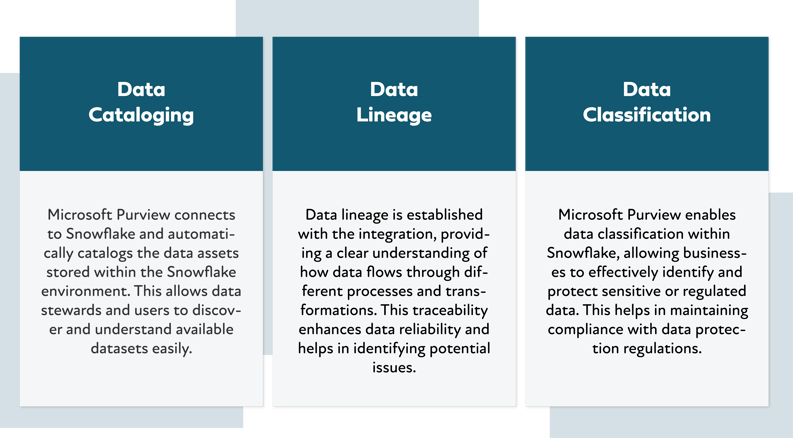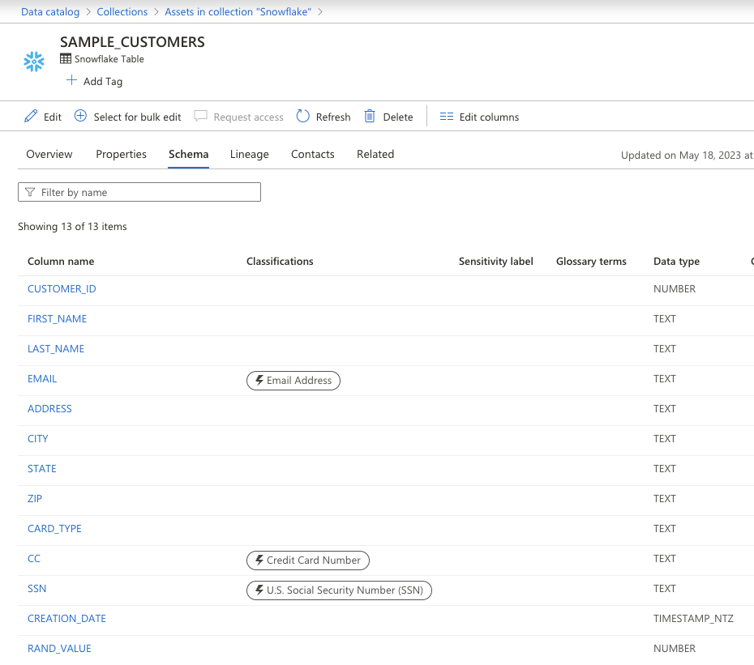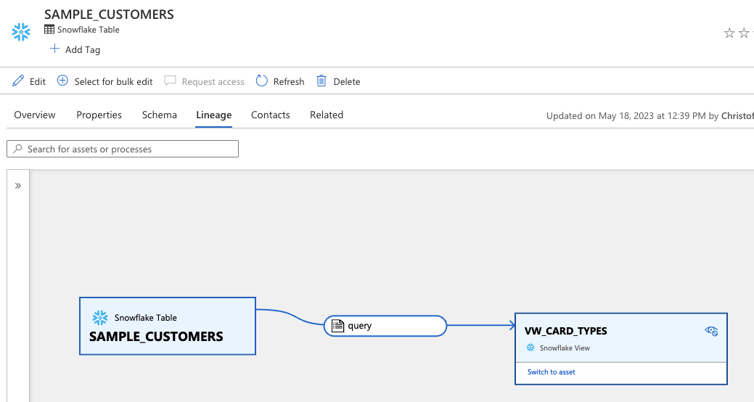Data governance is crucial to modern data management. Data governance is the process a company takes to ensure its data is accurate, available, usable, secure, and meets compliance standards to successfully make business decisions. Microsoft Purview is a comprehensive data governance service that empowers organizations to effectively discover, catalog, and govern their data assets. In this blog, we will explore the powerful integration of Snowflake—a robust cloud data platform—and Microsoft Purview, analyzing how these tools help unlock a seamless and powerful data governance solution.

Understanding Snowflake and Microsoft Purview Integration
Snowflake is renowned for its cloud-native data warehousing capabilities, offering unparalleled scalability and performance. Snowflake’s platform can be broken down into multiple layers that customers can take advantage of. Customers can optimize storage and deploy a range of architectural patterns (data lakes, data warehouses, data meshes, and others), reduce risk with its elastic multi-cluster compute capabilities, utilize Snowflake’s cloud services to automate and scale their workloads cost-effectively, and discover and share governed data between teams, partners, customers, and more with Snowgrid.
On the other hand, Microsoft Purview provides a unified and intuitive data governance service that enables businesses to manage their data across various platforms. It offers businesses a unified map of its data assets and their relationships for more effective data governance, a glossary with business and technical search terms to aid data discovery, insights into the management of sensitive data across their entire data estate, and in-house data sharing in near real time and easy provisioning of data access.
Together, the integration between Snowflake and Microsoft Purview brings the strengths of both platforms to create a holistic data governance ecosystem. A few key features include data cataloging, data lineage, and data classification.

To effectively demonstrate the collaboration between Microsoft Purview and Snowflake's integration, we have gathered illustrative diagrams highlighting the seamless coupling of these tools to facilitate data cataloging, classification, and the establishment of data lineage.
In the initial diagram, the schema generated by Purview comes to the forefront, having undergone a thorough crawl of the Snowflake data warehouse. This schema boasts a distinct classification column, a testament to Purview's data classification capabilities. This classification column seamlessly interfaces with the governance modeling process, enhancing the overall data management framework.

The following diagram provides a vivid portrayal of Purview in action, specifically highlighting its role in delineating data lineage within the intricate data model housed within Snowflake. This lineage tracing is a crucial aspect that further integrates with Purview's governance modeling and proves effective data oversight.

Some benefits of this integration include comprehensive data governance, enhanced data discovery, regulatory compliance, and data trustworthiness.
- Comprehensive data governance: The combined power of Snowflake and Microsoft Purview offers a robust data governance solution, providing end-to-end visibility and control over data assets.
- Enhanced data discovery: Users can easily search for and identify relevant data assets within Snowflake, improving productivity and reducing data duplication.
- Regulatory compliance: The integration allows businesses to classify sensitive data accurately and monitor its usage, ensuring adherence to data protection regulations.
- Data trustworthiness: Data lineage and classification features instill confidence in the data's accuracy and reliability, promoting informed decision-making.
The integration of Snowflake with Microsoft Purview brings a game-changing data governance solution to the table. Organizations can harness the power of Snowflake's cloud data platform while maintaining complete control and compliance with Microsoft Purview's data governance capabilities. By ensuring comprehensive data discovery, lineage tracking, and classification, businesses can unleash the true potential of their data and drive success in their data-driven initiatives.
Categories
- Cloud Migration and Adoption
- Enterprise IT and Infrastructure
- Artificial Intelligence and Machine Learning
- Data Management and Analytics
- DevOps and Automation
- Cybersecurity and Compliance
- Application Modernization and Optimization
- Featured
- Managed Services & Cloud Cost Optimization
- News
- Workplace Modernization
- Tech We Like
- AWS
- Social Good News
- Cost Optimization
- Hybrid Cloud Strategy
- NVIDIA
- Application Development
- GPU




